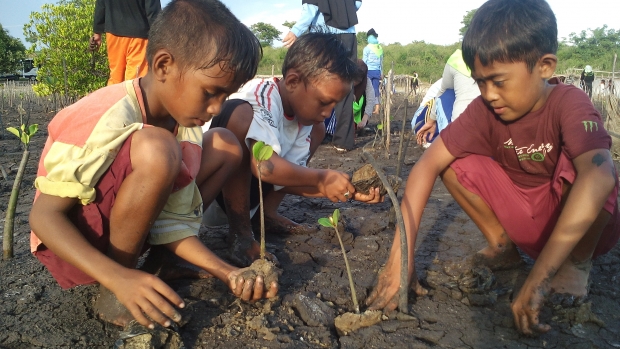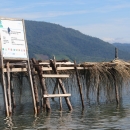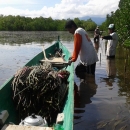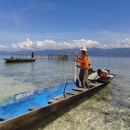Grants :: Small Grant Facilities :: Women's Group Empowerment through Livelihood Improvement and Mangrove Rehabilitation
Women's Group Empowerment through Livelihood Improvement and Mangrove Rehabilitation

Children taking part in mangrove planting, Torosiaj Village, Popayato District, Pohuwato Regency, Gorontalo Province © MFF IUCN, 2014
Objectives
To improve community livelihood and to improve mangrove ecosystem management
Background
The mangrove ecosystem of Torosiaje cluster (Torosiaje, Torosiaje Jaya and Bumi Bahari villages) mostly associated with sea grass and coral reef, with long frequent inundation. The mangrove areas in southern part of the cluster growths on the back of sandy beach.
Based on the quantified spatial analyses, the Torosiaje cluster has a total of 402.62 ha mangrove areas, divided into mangrove forest (181.80 ha) and potential mangrove areas/open area (220.82 ha). The potential mangrove areas defined as open areas which ecologically has potential for mangrove growth, and then added by feasibility variable and considering social aspect as well as spatial plan.
Based on the total areas, it is clear that the mangrove forest has less areas than the non-forested areas. This indicates changes of land cover and land use in the cluster villages. The satellite imagery shows that most of the mangrove areas in Torosiaje Jaya village has been converted into fish ponds.
The threats to mangrove ecosystem closely linked with the direct interaction of local community to the mangrove areas. The land conversion for fish ponds and fire-wood collection for domestic uses are considered as the two main threats to the mangrove ecosystem. On the other hand, the human transportation by engine boat often destruct newly planted mangrove seedlings.
Target beneficiaries
The direct benefits will be for the residents of Torosiaje village.
Outputs
- 103,000 mangrove seedlings were planted to rehabilitate 10 Ha mangrove area. The growth rate was 85%;
- Some stakeholders visited the mangrove planting site of KSL Paddakauang as part of learning processes;
- KSL Paddakauang was granted a mangrove seedlings certificate – local government endorsement;
- About 109 Ha mangrove area was in the process of having certificate of Community Mangrove Forest Concession – local government endorsement;
- Reef fish culture with floating cage method – 12,000 juveniles were reared on 20 cages and managed by 4 fishermen groups.
Accomplishments and challenges
- A total of 5 groups where each group consisted of 4 members (total 20 people) participated during the early initiation of the project. This number growing to 8 people per group (total 40 people) during the last monitoring on March 2015;
- Training on the reef fish culture had been implemented for 2 days, participated by 20 community group members;
- A total of 114,000 seedlings (of the originally proposed 85,000 seedlings – 134%) had been planted in nursery, of which 103,000 had been planted in the 7.4 ha rehabilitation sites (Bonda, Buko, Pataan, Natural Laboratory and Maruaangi Kecil island). Total rehabilitation areas: 10 ha
- The livelihood improvement programme was focused on the reef fish culture. The following activities have been implemented aimed on the improvement of community’s livelihood:
- Provision of 20 fish cage has been distributed to 4 community group (4 pcs per group)
- A unit of fish net has been provided to be used to catch smaller fishes as food of caged fishes
- A total of 8,000 fish seeds have been distributed to community groups (each group received 2,000 fish seeds)
- In addition, group members provided self-provision of 900 bobara fish and 100 tiger groupers
- The anticipated first harvest will yield around Rp.127 million
Contributions to cross-cutting themes
- Climate change and disaster risk reduction
103,000 mangrove seedlings were planted to rehabilitate 10 Ha mangrove area in order to restore the ecosystem health in the area.
- Knowledge management and communications
Some stakeholders visited the mangrove planting site of KSL Paddakauang as part of learning processes.
Lessons Learned
- Seedlings should be planted (nursery site should be located) near inter tidal zone and exposed to brackish water. Limited access to inter tidal zone and brackish water will increase seedling mortality rate, especially when the planting/propagation is initiated at the beginning of dry season.
Project Facts
Country
Location
Torosiaje Jaya village, Popayato District, Pohuwato Regency, Gorontalo Province
Topic
Duration
6th May 2014 to 5th May 2015
MFF Grant Amount
IDR 198,775,000
Implementing Partner
Kelompok Sadar Lingkungan (KSL) Paddakauang, Torosiaje Jaya Village
Jalan Trans Sulawesi Kec.Popayato, Desa Torosiaje Jaya
Contact person: Mr Umar Pasandre, Project Manager
Mobile: +6285256236985
Email address: pasandreumar@gmail.com


